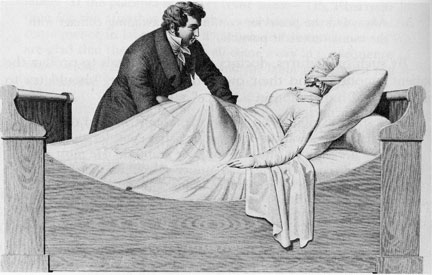This past week, we studied two subjects that I am very passionate about - evidence based practice and patient education. Evidence based practice dictates what we do and how we do it. The first application of evidence based practice was in the 1800s when a physician noticed that women who delivered at home had much less rates of childbed fever (a septic infection that killed the moms a few days after they gave birth). The doctor started washing his hands before working with his patients (postpartum women). He quickly noticed that he too had much lower rates of childbed fever than other doctors in the area. Other doctors would go straight from an autopsy to the delivery room without washing their hands (yes, I know - DISGUSTING!). He told the other doctors to start washing their hands to protect their patients. However, the sad and scary thing is that the other doctors didn't like having to take the extra few seconds to wash their hands and so refused and even kicked the hand-washing doctor out of the country! Not surprisingly, the rates of childbed fever shot up again.

This week, we're having to write a paper about some form of evidence based practice and I (unsurprisingly) chose a childbirth related topic. In the year 2000, the Term Breech Trial released a report that significantly more babies born in the breech position died from being born vaginally than from Cesarean sections. Midwives were suddenly banned from attending breech deliveries and doctors stopped allowing vaginal breech births (except for the accidental ones where the mom walks into the hospital with her baby's butt hanging out...you get the picture).
 |
| Breech babies frequently keep their legs in this position for several days after birth. |
Recently, childbirth professionals started looking more closely at the Term Breech Trial and discovered that their results aren't as obvious and dramatic as originally claimed. In fact, the trial tried to add mortality results from 3rd world countries (which already have high maternal and neonatal mortality rates regardless of how normal the birth is) with 1st world countries! Also, quite a few of the vaginal births used in the study violated the terms of the study. For instance, the study said the baby must be a non-footling breech (either frank or complete breech), there must only be one baby (no twins!), the baby must be alive at the start of labor (you would think this one would be a "duh!" but read on...), the baby must not have any congenital defects (no heart or brain or chromosomal conditions), and the birth must be attended by an experienced birth attendant (again, another aspect you'd expect to be a "duh!").
 |
| Different types of breech positions - note the baby's feet |
However, the study included several footling breeches, several sets of twins, several babies who were "probably" dead before their moms joined the study, at least one baby who had a congenital problem, and many of the births were NOT attended by experienced clinicians. Yet all the results - and resulting deaths - were added to the study under the vaginal breech birth category. Also, the study "forgot" to mention that more moms died from a routine Cesarean section than from a vaginal birth.
 |
| Healthy mommy, healthy baby! :-D (And yes, in case you were wondering, I took this image) |
For several years, a Cesarean became the only way to give birth to a breech baby. However, some European countries examined the study and conducted their own evaluations and discovered the Term Breech Trial results were wrong. When all results and extenuating circumstances are equal (healthy mom and baby, experienced birth attendant, resuscitation equipment ready, etc), the mortality rates were for babies were practically the same. However, the maternal mortality rates were significantly lower for moms having vaginal deliveries instead of Cesarean deliveries. Thankfully, some clinicians are starting to change their policies and "allow" vaginal breech births!
 |
| Once again, another picture I took :-D |
If anyone wants to read the articles I'm using for my paper to validate what I wrote, the articles can be found here:
http://onlinelibrary.wiley.com/doi/10.1111/j.1523-536X.2011.00507.x/pdf
http://connection.ebscohost.com/c/articles/95894341/re-engaging-vaginal-breech-birth-philosophical-discussion
http://openaccess.city.ac.uk/3680/
...Until next week!






No comments:
Post a Comment